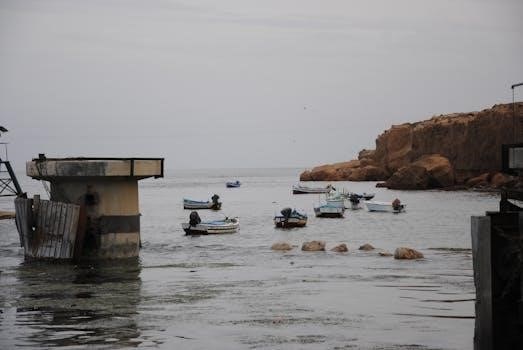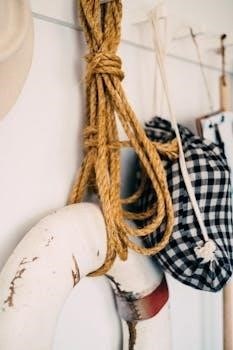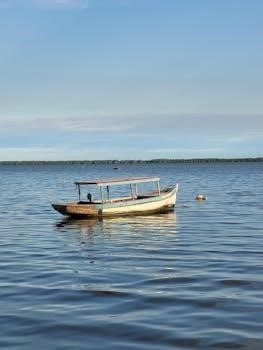buoy 10 fishing guides
- Published
- in Guide
Buoy 10 Fishing Guides⁚ A Comprehensive Plan
Planning a successful Buoy 10 salmon fishing trip requires a comprehensive approach. This guide provides essential information, from understanding the fishery’s significance to mastering effective techniques. Explore rod selection, lure choices like Brads Super Bait and Yakima Bait Spin Fish, and tidal influences.
Welcome to the exhilarating world of Buoy 10 salmon fishing, often hailed as the “Super Bowl” of salmon angling. Located near the mouth of the Columbia River, this unique fishery attracts anglers from far and wide, all eager to test their skills against the mighty Chinook and Coho salmon. This section serves as your entry point to understanding the allure and complexities of Buoy 10.
Buoy 10 is more than just a fishing spot; it’s an experience. The confluence of the river’s freshwater and the ocean’s saltwater creates a dynamic environment teeming with life, making it a prime location for salmon as they begin their upstream migration. The sheer volume of fish, combined with the stunning scenery, makes for an unforgettable adventure.
However, success at Buoy 10 requires knowledge and preparation. The currents can be strong, the tides unpredictable, and the competition fierce. Understanding the nuances of the fishery, from the best times to fish to the most effective techniques, is crucial for a rewarding experience. Get ready to dive in and discover the secrets of Buoy 10!
Understanding Buoy 10’s Significance
Buoy 10 holds a special place in the hearts of salmon anglers, and understanding its significance is key to appreciating its unique appeal. This fishery marks the transition zone where salmon, fresh from the ocean, begin their journey upstream to spawn. This concentration of fish creates a remarkable opportunity for anglers.
The location near the Columbia River’s mouth contributes to Buoy 10’s importance. The mixing of fresh and saltwater creates a nutrient-rich environment that attracts salmon. As the fish stage in this area, they are often in prime condition, making for exciting battles and rewarding catches.
Furthermore, Buoy 10 is more than just a fishing destination; it’s an economic driver for local communities. The annual salmon run draws anglers, boosting tourism and supporting businesses. Responsible fishing practices are essential to ensure the long-term health of the fishery and the sustainability of the region’s economy. Therefore, appreciating Buoy 10’s significance encompasses environmental and economic aspects.

Essential Gear and Tackle for Buoy 10
Success at Buoy 10 hinges on having the right gear; This section details essential equipment, including rod and reel selection, recommended lures like Brads Super Bait, and terminal tackle such as dropper weights and appropriate trolling setups for optimal results.
Rod and Reel Selection for Buoy 10
Choosing the right rod and reel is paramount for a successful Buoy 10 fishing experience. Given the strong currents and the potential for hooking large salmon, a robust setup is essential. Rods in the 8’6″ to 10’6″ range, designed for salmon or steelhead, are generally preferred. Look for models with a medium-heavy to heavy power rating to handle the weight of the gear and the fight of a powerful fish.
For reels, both conventional and level-wind models are suitable, provided they have a reliable drag system. A reel with a line capacity of at least 200 yards of 20-30 pound test monofilament or braided line is recommended. The drag system should be smooth and capable of applying consistent pressure to tire out the salmon without breaking the line.
Consider factors such as rod action (moderate to fast) to allow for good hook sets and the ability to control the fish in strong currents. Matched properly, your rod and reel will be a huge part of your success.
Recommended Lures and Baits⁚ Brads Super Bait and Yakima Bait Spin Fish
When it comes to enticing salmon at Buoy 10, certain lures and baits consistently outperform others. Two standouts are Brads Super Bait and Yakima Bait Spin Fish. Brads Super Bait, known for its ability to hold scent effectively, allows anglers to create a potent and long-lasting attractant. Fill it with your favorite salmon scent or tuna, and you’re ready to go.
Yakima Bait Spin Fish lures are equally effective, with their spinning action and vibrant colors drawing strikes from aggressive salmon. These lures can be rigged with or without bait, making them versatile for different fishing conditions. Experiment with various colors and sizes to determine what the salmon are keying on during your trip.
When using these lures, ensure they are properly rigged with sharp hooks and strong leaders. Regularly check your bait and lures to ensure they are clean and free of debris, maximizing their effectiveness in the water. Consider using scent attractants in conjunction with the lures.
Terminal Tackle⁚ Dropper Weights and Trolling Setups
Buoy 10 fishing success hinges significantly on the correct terminal tackle. Dropper weights and trolling setups are essential for presenting your bait effectively in the strong currents. A standard Buoy 10 trolling setup includes a cannonball weight on a slider, allowing the weight to move freely while keeping your lure at the desired depth.
The weight of the cannonball varies based on the current; typically, 8 to 16 ounces is sufficient. The slider setup prevents the fish from feeling the weight immediately, improving hookup ratios. The leader connecting your lure to the slider should be strong, abrasion-resistant fluorocarbon.
Dropper weights, attached via a dropper line to the main line, also help maintain depth. The length of the dropper line can be adjusted to fine-tune lure presentation. Ensure all connections are robust, using quality swivels and snaps to prevent line twists and break-offs. Regular inspection of your terminal tackle for wear is crucial for landing that trophy salmon.

Buoy 10 Fishing Techniques and Strategies
Mastering Buoy 10 requires specific techniques. Trolling is key, utilizing the flood tide effectively. Understanding tidal movements is crucial for positioning your boat and presenting lures correctly. Adapt your strategy based on the tide’s stage for optimal results.
Trolling Techniques at Buoy 10
Trolling is the predominant fishing technique at Buoy 10, requiring precise boat control and lure presentation. Success hinges on maintaining the correct speed, typically slow, to allow salmon ample opportunity to strike. Utilize downriggers or divers to achieve the desired depth, targeting areas where salmon are actively feeding.
Experiment with different trolling patterns, such as zig-zagging or making wide turns, to cover more water and locate concentrations of fish. Pay close attention to your fish finder to identify submerged structures or changes in depth that may attract salmon. Adjust your trolling speed and depth accordingly.
Effective trolling also involves precise lure placement. Keep your lures within the strike zone by monitoring your line counter and adjusting your downrigger or diver settings. Be prepared to make quick adjustments based on changing tidal conditions and the behavior of the salmon. Consider using a GPS to mark productive trolling lanes for future reference.
Finally, remember that communication is vital. Coordinate with other anglers to avoid crossing lines and ensure everyone has a fair chance at catching fish. Observing successful anglers and adapting their techniques can also improve your trolling effectiveness at Buoy 10.
Importance of Tide⁚ Fishing the Flood Tide
The tidal influence is paramount at Buoy 10, dictating salmon behavior and fishing success. The flood tide, when the river’s water level rises as the ocean pushes in, is often considered the prime time to fish. During the flood, salmon actively move upstream, following the incoming current, creating concentrated feeding opportunities.
Understanding the nuances of the flood tide is crucial. As the tide begins to rise, salmon tend to stage lower in the river, near the mouth, waiting for the incoming surge. Anglers targeting these staging areas often experience early success. As the flood progresses, salmon continue their upstream migration, spreading throughout the fishing zone.
Positioning your boat strategically during the flood tide is essential. Focus on areas where the current creates seams or edges, providing ambush points for salmon. These areas may include channel edges, submerged structures, or points where smaller tributaries enter the main river. Pay attention to how the current interacts with these features.
Adjust your fishing techniques to match the tidal flow. As the current increases, you may need to increase your trolling speed or use heavier weights to maintain proper lure presentation. Conversely, as the tide slows, you may need to reduce your speed and weight. Observing the water conditions and adapting accordingly will maximize your chances of success.

Understanding and Utilizing Tides Effectively
To master Buoy 10 fishing, a comprehensive understanding of tides is essential. Tides are the periodic rise and fall of ocean waters, primarily caused by the gravitational forces of the moon and sun. In the Buoy 10 fishery, tides dramatically influence salmon behavior, water currents, and fishing success.
Consulting a tide chart or app is the first step in understanding the tidal patterns. These resources provide detailed information about the predicted high and low tide times, as well as the tidal range (the difference between high and low tide). Note the times of slack tide, when the current is minimal, and the peak flood and ebb currents.
Observe the actual water conditions to validate the tidal predictions. Wind, river flow, and barometric pressure can all affect the actual tide levels and currents. Pay attention to how these factors deviate from the predicted tides.
Utilize tidal information to plan your fishing strategy. Fish the flood tide aggressively, focusing on areas where salmon are likely to be moving upstream. During the ebb tide, target areas where salmon may be holding or seeking refuge from the strong current. Adjust your fishing techniques and lure presentations to match the changing tidal conditions. Remember that experienced anglers often cite the flood tide as the most productive time.

Key Buoy 10 Fishing Tips
Unlock Buoy 10 success with these essential tips! From tide awareness to lure selection, mastering these strategies will significantly improve your salmon fishing. Prioritize patience, observation, and adaptability for a memorable and productive experience on the water.
Ten Essential Tips for Successful Fishing
- Wait Patiently⁚ Buoy 10 fishing demands patience. Salmon runs fluctuate, so be prepared to wait for the bite. Don’t get discouraged by slow periods; persistence often pays off.
- Tide Awareness 1.0⁚ The tides dictate salmon movement. Fish the flood tide aggressively, as salmon tend to move upstream with the incoming water.
- Tide Awareness 2.0⁚ Understand the tidal range. Larger tidal swings often concentrate fish, creating more productive fishing conditions. Consult tide charts meticulously.
- Tide Awareness 3.0⁚ Start low on the river during the flood tide. This allows you to intercept salmon as they enter the estuary. Adjust your position as the tide rises.
- Embrace Dropper Weights⁚ Utilize a dropper weight and trolling setup. This standard rig helps keep your bait in the strike zone, especially in strong currents.
- Brad’s Super Bait and Yakima Bait Spin Fish⁚ Carry a selection of Brads Super Bait and Yakima Bait Spin Fish. These lures are proven producers at Buoy 10;
- Observe Others⁚ Pay attention to what other successful anglers are doing. Note their lure choices, trolling speeds, and depth settings.
- Adapt Your Tactics⁚ Be willing to change your approach based on conditions and fish behavior. Don’t be afraid to experiment with different lures and techniques;
- Check Regulations⁚ Stay informed about current fishing regulations. Ensure you are following all rules regarding seasons, size limits, and gear restrictions.
- Safety First⁚ Prioritize safety at all times. Wear a life jacket, be aware of boat traffic, and monitor weather conditions.
